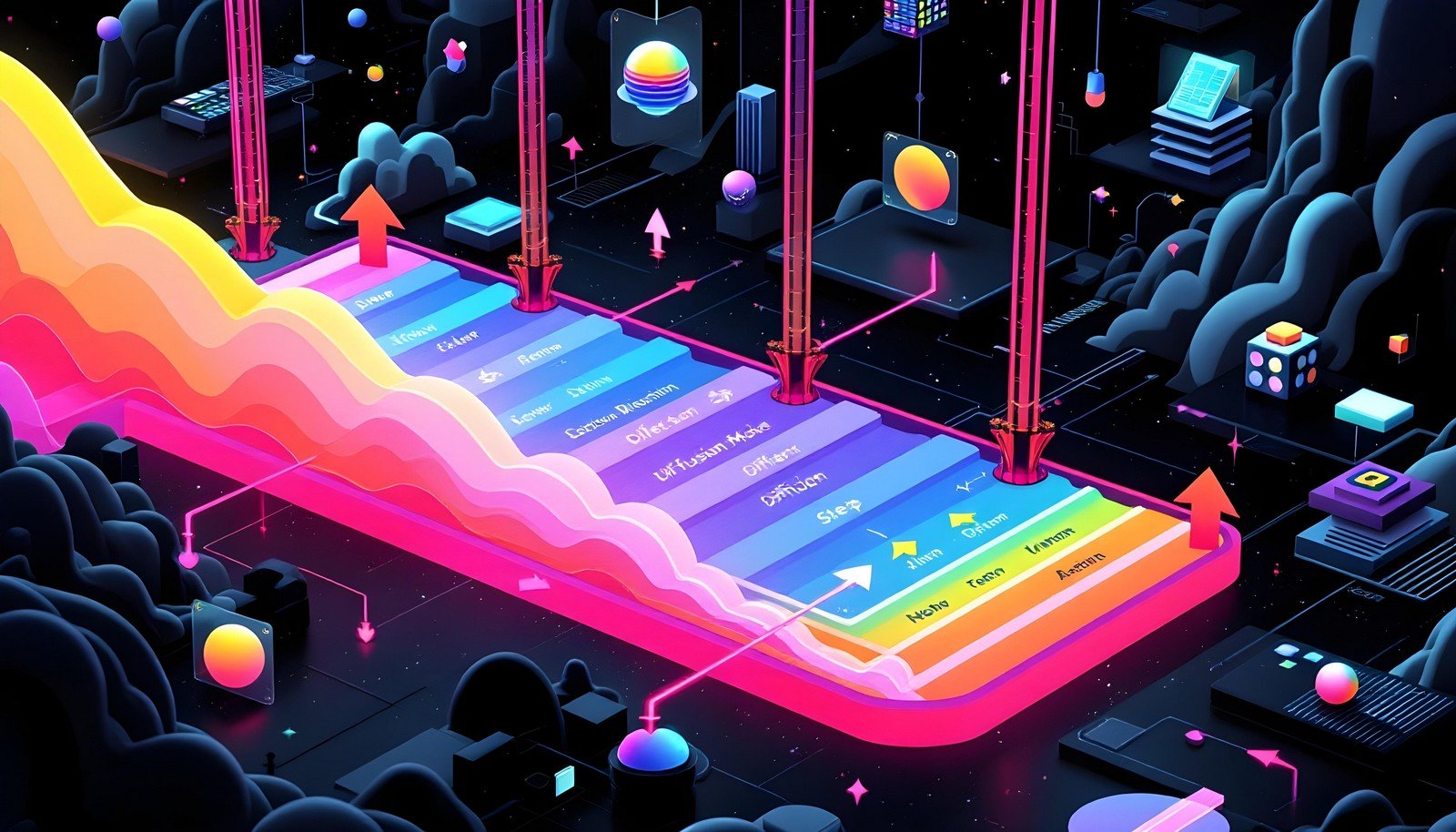Diffusion Model

Quick Navigation:
- Diffusion Model Definition
- Diffusion Model Explained Easy
- Diffusion Model Origin
- Diffusion Model Etymology
- Diffusion Model Usage Trends
- Diffusion Model Usage
- Diffusion Model Examples in Context
- Diffusion Model FAQ
- Diffusion Model Related Words
Diffusion Model Definition
A Diffusion Model is a type of generative model primarily used in machine learning and statistics to generate data similar to a given dataset. It functions by simulating a step-by-step process in which data is gradually degraded and then reconstructed. This process typically involves adding noise to data (the forward process) and then learning to reverse this noise to generate high-quality outputs (the reverse process). Diffusion models have become especially popular for tasks involving image and audio generation due to their ability to produce detailed, high-resolution results. They are based on probabilistic frameworks and leverage techniques like Markov chains.
Diffusion Model Explained Easy
Imagine you have a picture made of tiny dots, and you slowly start adding random dots (or noise) over time until the picture is so blurry that you can barely see what it was. A Diffusion Model learns how to turn that blurry picture back into the original, clear picture by removing the noise step by step. It’s like teaching a computer to unmix a scrambled puzzle until it looks just right again.
Diffusion Model Origin
Diffusion models are rooted in the study of stochastic processes and were initially inspired by physics, particularly concepts related to heat diffusion. The breakthrough application of these models in machine learning started gaining traction in the late 2010s, with researchers looking for more effective ways to generate synthetic data, surpassing earlier methods like GANs (Generative Adversarial Networks) in specific areas.
Diffusion Model Etymology
The term ‘diffusion’ comes from Latin ‘diffusio,’ which means ‘spreading out.’ This is reflective of how noise is added and spread throughout data before being reversed.
Diffusion Model Usage Trends
Diffusion Models have seen a sharp rise in popularity due to their performance in high-quality data generation, especially with the advent of deep learning architectures that facilitate their training. Their application extends beyond image synthesis to areas such as text-to-image generation and audio synthesis, drawing attention from both academic researchers and industry practitioners. Diffusion models are recognized for their flexibility and the high level of detail they bring to generative tasks, making them increasingly favored over traditional models in recent years.
Diffusion Model Usage
- Formal/Technical Tagging:
- Generative modeling
- Machine learning
- Image synthesis
- Stochastic processes - Typical Collocations:
- Diffusion model training
- Noise addition in diffusion
- Reverse diffusion process
- Probabilistic modeling with diffusion
Diffusion Model Examples in Context
- “The researchers utilized a Diffusion Model to generate highly realistic images of landscapes.”
- “With the implementation of advanced Diffusion Models, the audio synthesis process became significantly more nuanced and lifelike.”
- “This new text-to-image software is powered by a Diffusion Model that ensures high-definition outputs.”
Diffusion Model FAQ
- What is a Diffusion Model used for?
Diffusion Models are used for generating synthetic data, especially high-quality images and audio. - How do Diffusion Models work?
They work by adding noise to data in a forward process and learning to reverse this noise to recreate the original data. - Are Diffusion Models better than GANs?
In some applications, yes. Diffusion Models often produce more detailed outputs compared to GANs. - What fields use Diffusion Models?
Primarily in machine learning for tasks involving generative data synthesis, such as art, video, and audio generation. - What is the main challenge in training Diffusion Models?
The process can be computationally intensive and may require substantial resources. - Who first introduced Diffusion Models?
The concept draws from early work in physics but was adapted for machine learning by various researchers in the late 2010s. - Can Diffusion Models be used for text generation?
Yes, adaptations of Diffusion Models have been explored for text and other sequential data. - How long does it take to train a Diffusion Model?
It depends on the complexity of the data and the computational resources but can range from several hours to weeks. - Are there any well-known Diffusion Model implementations?
Yes, DALL·E 2 and Stable Diffusion are famous examples. - Why are Diffusion Models important?
They provide a robust alternative for high-quality data generation, enabling new levels of creativity and detail in AI applications.
Diffusion Model Related Words
- Categories/Topics:
- Generative AI
- Deep learning
- Computer vision
- Audio synthesis - Word Families:
- Diffuse
- Diffusion process
- Generative model
- Stochastic modeling
Did you know?
Diffusion Models gained significant attention when they were successfully used in the creation of AI-generated art, like DALL·E 2 and Stable Diffusion, which sparked discussions on the future of AI creativity and its potential implications for artists and content creators.
PicDictionary.com is an online dictionary in pictures. If you have questions or suggestions, please reach out to us on WhatsApp or Twitter.Authors | Arjun Vishnu | @ArjunAndVishnu

I am Vishnu. I like AI, Linux, Single Board Computers, and Cloud Computing. I create the web & video content, and I also write for popular websites.
My younger brother, Arjun handles image & video editing. Together, we run a YouTube Channel that's focused on reviewing gadgets and explaining technology.



Comments powered by CComment